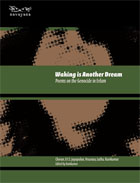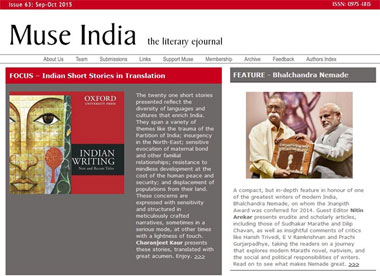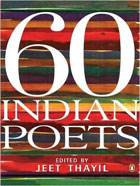Publishing Poetry in India

While commentators periodically lament the death of poetry publishing in India, Ranjit Hoskote argues otherwise. The poets inhabit a literary subculture backed up by an array of journals and anthologies committed to identifying, contextualising and publishing poetry, and providing them with a literary and historical backdrop.
In an excerpt from his essay, “New ecologies of poetry in India” (first published in Art & Thought, Goethe-Institut, Köln, September 2015), he outlines the role of various publishers and their initiatives, journals, e-journals, collections and anthologies in enabling resurgence for Anglophone poetry in India.
Publishers and Initiatives
Mainstream publishers are often accused of ignoring the claims of poets, and yet volumes of poetry continue to appear under prestigious imprints. HarperCollins India has supported a poetry list that embraces work in English as well as in translation. It includes Karthika Nair’s Bearings, Tishani Doshi’s Everything Begins Elsewhere, Priya Sarukkai Chabria’s Not Springtime Yet, Farrukh Dhondy’s translation of Rumi from the Persian, and Sampurna Chattarji’s translation of Joy Goswami’s Selected Poems from the Bengali.Penguin Books India (now Penguin Random House India) continues to bring out several books of poetry every year. In recent years, Penguin has published Arvind Krishna Mehrotra’s Collected Poems, Gulzar’s Selected Poems (translated from the Urdu by Pavan Varma), Amir Khusrau’s In the Bazaar of Love (translated by Paul Losensky and Sunil Sharma from the Persian and Hindavi), Guru Gobind Singh’s Zafarnama (translated from the Persian by Navtej Sarna), as well as the extraordinary anthology of Indian poetry spanning four millennia from Vedic antiquity to the present, These My Words, edited by Eunice de Souza and Melanie Silgardo. A declaration of interest here: Penguin has published my translation of the 14th-century Kashmiri mystic Lal Ded, I, Lalla: The Poems of Lal Ded, as well as my edition of Dom Moraes’ Selected Poems and my most recent collection of poems, Central Time.
The scene is also sustained by dynamic independent publishing initiatives that locate themselves in a genealogy reaching back to the Clearing House imprint of the mid-1970s, run by a group of poets including Adil Jussawalla, Arun Kolatkar, Arvind Krishna Mehrotra, Dilip Chitre and Gieve Patel. The front-runner among such initiatives today is Poetrywala, directed by Hemant Divate, who combines a practising poet’s inspired commitment with a marketing entrepreneur’s professional skills. In the early 1990s, Divate published the Marathi literary journal, Abhida, which later evolved into a quarterly, Abhidanantar. Poetrywala, which he set up a few years ago, has nearly 50 titles in print, an astonishingly large number in a supposedly constrained market.
Under the Poetrywala imprimatur appear younger voices like Mustansir Dalvi (Brouhahas of Cocks), Sampurna Chattarji (Absent Muses), Arun Sagar (Anamnesia) and Anand Thakore (Mughal Sequence and Elephant Bathing). Also represented are members of earlier generations in Anglophone Indian poetry: canonical figures like Dilip Chitre (As Is, Where Is), Vilas Sarang (Another Life) and Manohar Shetty (Body Language). Poetrywala also publishes overseas authors like the Israeli poet-scholar Tsippy Levine Byron (Lucid Words) and the Rome-based Zingonia Zingone (Acrobat of the Oblivion).
Navayana, a publishing house founded by the activist and editor S Anand and dedicated to Dalit writing, has courageously taken on the challenge of publishing poetry that emerges from conditions of ostracism, terror, conflict and resistance. Navayana has published the legendary Dalit (formerly ‘untouchable’) poet Namdeo Dhasal’s A Current of Blood, translated from the Marathi by Dilip Chitre, andMeena Kandasamy’s Ms Militancy, which explores and articulates a contemporary feminist position. Navayana has also published Anushiya Ramaswamy’s translation of N D Rajkumar’s startlingly visceral poems as Give Us This Day A Feast of Flesh, as well as an anthology of poems by those who have suffered genocide in Tamil-majority northern Sri Lanka, Waking is Another Dream (translated from the Tamil by Meena Kandasamy and Ravi Shanker).
 Waking is Another Dream - Poems on the Genocide in Eelam by Cheran, Jayapalan, Yesurasa, Latha, Ravikumar, Pub: Navayana
Waking is Another Dream - Poems on the Genocide in Eelam by Cheran, Jayapalan, Yesurasa, Latha, Ravikumar, Pub: NavayanaInvisible though it may seem to the reading public at large, the Sahitya Akademi, India’s National Academy of Letters, has maintained a consistent and vigorous programme of translation and publication. The Akademi brings poetry from the subcontinent’s diverse linguistic universes into English, building up an open-ended library of voices from Assamese, Dogri, Kashmiri, Telugu, Kannada, Gujarati, Rajasthani and other regional literatures. It has published the debut collections of several Anglophone poets, including Priya Sarukkai Chabria (Dialogue and Other Poems), Sampurna Chattarji (Sight May Strike You Blind) and Sridala Swami (A Reluctant Survivor). As is evident from these literary and publishing models, translation surges through the contemporary Indian literary scene as a vital, replenishing energy. It ensures that, no matter what one’s own chosen language of expression might be, one can delight in the pleasures and surprises of an opulently multilingual environment.
Journals and E-journals
Meanwhile, journals and magazines continue to play a crucial role in presenting and disseminating poetry, not as fragmentary, episodic or purely subjective cultural production, but rather as a sustained engagement with the public sphere and its debates over citizenship, belonging and civic assertion. In this spirit, some publications have expanded their editorial practice into other arenas, such as the literary festival, thus embodying the fluctuating and widely dispersed relations between writers and readers concretely in a single time, place and form of assembly.
E-Journal Muse India
#Muse India, a literary e-journal founded by a group of writers in Hyderabad and edited by G S P Rao, adopts the format of domain-wise sections and infuses it with fresh vibrancy. It not only surveys a range of South Asian languages, but also addresses writing from the South Asian global diaspora, developments in Dalit literature, and contributions by poets working in haiku and other short verse forms. Muse India carries its commitment from the page to the live encounter with the literary community by organising the annual Hyderabad Literary Festival, the sixth edition of which was held this January.Founded in 1940, discontinued in 1988 and relaunched in 2010 as a magazine devoted to long-form journalism, The Caravan has a distinguished history as well as the productive ambition to map itself against The New Yorker and Granta. It boasts a books section, edited by poet and novelist Anjum Hasan, and a fiction and poetry section, edited by the novelist and anthologist Chandrahas Choudhury. Both literary editors demonstrate a nuanced curatorial sensibility in their selection and framing of contemporary Indian literature. For young poets, in particular, such a curatorial procedure, with its history-in-the-making approach, offers lessons both in aesthetic criteria and critical tonality.
The Indian Quarterly, edited by senior journalist, biographer and curator Madhu Jain, includes a section dedicated to contemporary poetry. Sangam House, an international writers’ residency programme directed by Sanskritist Arshia Sattar and writer D W Gibson, supports ‘Poetry at Sangam’, a section on its website, www.sangamhouse.org, featuring poems as well as essays on poetics. The venerable Kavya Bharati, published by the Study Centre for Indian Literature in English and Translation (SCILET), Madurai, remains active, as does the Journal of the Poetry Society of India, published half-yearly by the Society and edited by H K Kaul. Since 1988, the Society has run the influential British Council/ Poetry Society of India annual poetry competition, publishing the competition long-lists as annual anthologies.
Among the younger journals making their presence felt, online and in print, are Coldnoon: Travel Poetics, The Four Quarters Magazine, Pyrta, The Northeast Review, and Nether. Each of these journals experiments with thematic focus, temporality of publication and variable combinations of print and online publication. For instance, Coldnoon: Travel Poetics, founded in 2011 by academic Arup K. Chatterjee in New Delhi when he was a student at the Jawaharlal Nehru University, melds a focus on interdisciplinary academic writing with a concern with the poetic text. An international journal of travel writing, Coldnoon takes mobility and nomadism as key contemporary conditions, and published poetry that is transdisciplinary and transcultural in its tenor. It appears online as a quarterly, and in print twice a year.
Closely related in spirit to these journals are a number of literary platforms, which have dedicated themselves to nurturing a responsive climate for poetry. Such organic coalitions of poets and readers include Loquations, Bombay (founded by poet and anthologist Adil Jussawalla, now continued by poet and artist Jane Bhandari), the Red Leaf Poetry Group (founded by writer and media professional Linda Ashok in Hyderabad, it hosts readings, meetings and a website, and has also instituted a national poetry competition), The (Great) Indian Poetry Collective (established in Bangalore by poets Minal Hajratwala, Ellen Kombiyil and Shikha Malaviya, it hosts readings, conducts poetry workshops, and publishes books), and Cappuccino Readings (founded by poet and researcher Anjali Purohit, where poets meet readers in an unorthodox non-literary setting, the Starbucks flagship café at Horniman Circle, Bombay).
Collecting and Anthologizing
While journals and reading circles offer poets an interface with new audiences, anthologies provide them location within a community of practice, offer both poets and their readers a sense of belonging to a more compelling genealogy than the floating present. The anthology is a vastly underrated but powerful instrument of navigation.60 Indian Poets by Jeet Thayil. Pub: Penguin India
 During the last decade, Anglophone poetry in India has been blessed with a number of substantial anthologies. Jeet Thayil’s additive collection of poets began as Give the Sea Change and It Shall Change: Fifty-six Indian Poets (1952-2005), a special supplement in the fourth issue of the Massachusetts-based poetry journal, Fulcrum. It grew into the Penguin volume, 60 Indian Poets, and The Bloodaxe Book of Contemporary Indian Poets (both 2008). In 2012, Sudeep Sen published his anthology, The HarperCollins Book of English Poetry, bringing together 85 poets. Alongside these large anthologies must be placed Eunice de Souza’s Both Sides of the Sky: Post-Independence Indian Poetry in English (National Book Trust, 2008) and Arundhathi Subramaniam’s Another Country: An Anthology of Post-Independence Indian Poetry in English (Sahitya Akademi, 2013).
During the last decade, Anglophone poetry in India has been blessed with a number of substantial anthologies. Jeet Thayil’s additive collection of poets began as Give the Sea Change and It Shall Change: Fifty-six Indian Poets (1952-2005), a special supplement in the fourth issue of the Massachusetts-based poetry journal, Fulcrum. It grew into the Penguin volume, 60 Indian Poets, and The Bloodaxe Book of Contemporary Indian Poets (both 2008). In 2012, Sudeep Sen published his anthology, The HarperCollins Book of English Poetry, bringing together 85 poets. Alongside these large anthologies must be placed Eunice de Souza’s Both Sides of the Sky: Post-Independence Indian Poetry in English (National Book Trust, 2008) and Arundhathi Subramaniam’s Another Country: An Anthology of Post-Independence Indian Poetry in English (Sahitya Akademi, 2013).
Thayil and Sen have expanded the ambit of Anglophone Indian poetry, including practitioners from the historic Indian diasporas to the Caribbean and the South Pacific, as well as members of the 20th-century diasporas to North America, the UK and Europe. The formal range presented in these anthologies is formidable, with free verse jostling for space with ghazals, sonnets, rubais, sestinas, haikus and other classical forms. While members of the first three generations of Anglophone Indian poets are represented, younger or diasporic poets like Aditi Machado, Deepankar Khiwani, Sandeep Parmar, Michelle Cahill, Monica Ferrell and Mukta Sambrani also appear in the Thayil and Sen anthologies. The de Souza and Subramaniam anthologies, which also mix established with newer voices, have renewed the cartography of Anglophone Indian poetry. Both compilations feature the India-born Tibetan poet and activist Tenzin Tsundue, and Subramaniam includes the Mizoram-based poet Mona Zote.
In all these anthologies, the key political question of belonging is addressed, debated and reformulated in ways that correspond to the transformed, transcultural realities of experience in the early 21st century, far removed from the nationalist framework within which the ideas of India and Indianness were articulated in the late 19th century. I gestured towards this paradigm shift of aesthetic sensibility and political stance in the Introduction to my 2002 Viking anthology, Reasons for Belonging: Fourteen Contemporary Indian Poets, when I wrote that many Indian poets now writing “situate themselves resolutely in an elsewhereness that provides a deeper sense of location than mere locale. It bears an enigmatic, ambivalent, even contrapuntal relationship to the universe of the factual: the heterotopia of these poems could be a train station in Chennai, a library in Bombay, a circus in Gaya, or a Kerala river in spate; equally, it could be the Kabul Zoo, the scorching Deccan experienced in transit, the war-clouded Burma of family lore or a highway in upstate New York.”
To conclude…
To add to these traditional publishing spaces for poetry are the emergent venues of cyberspace. Far from having been eclipsed by the digital media, poetry has found new audiences through the democratisation of access that the internet and the social media, Twitter and Facebook, have made possible.Across India, and not only in its metropolitan centres, young poets engage with one another’s work and with the global ancestries they inherit, in reading circles and through online platforms. And when confronted with the threat of censorship, whether of the official kind legislated by the government or the informal coercion enforced by mob violence, poets in India increasingly join their fellow cultural practitioners – among them novelists, theatrepersons and filmmakers – in statements of protest, demonstrations, and the exploration of legal redress. This sense of solidarity was in evidence recently, when a number of poets joined other writers in returning their Sahitya Akademi awards to protest the Indian State’s silence on contentious communal issues and the assassination of dissident writers. Poets in India are taking the lead in voicing political dissent and opposing the rising tide of authoritarianism and illiberalism.
Ranjit Hoskote is a poet, cultural theorist and curator. He is the author of numerous books, including Die Ankunft der Vögel (Hanser, 2006), Kampfabsage (Blessing, 2007) and Central Time (2014).



